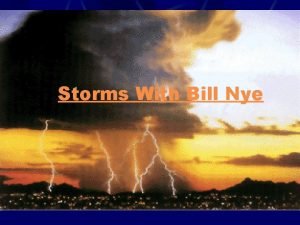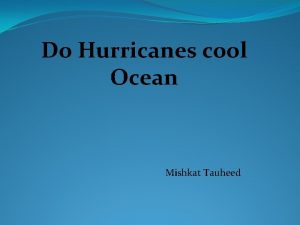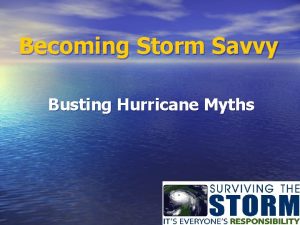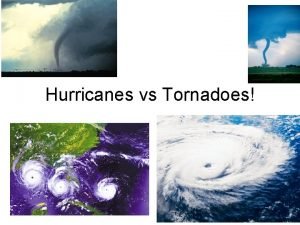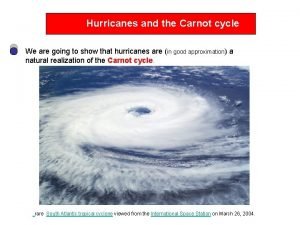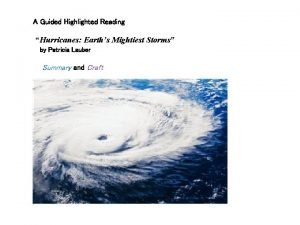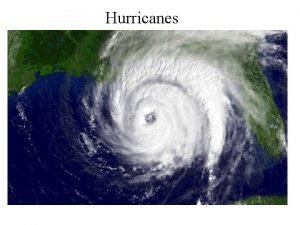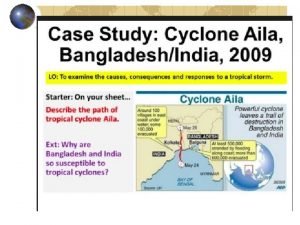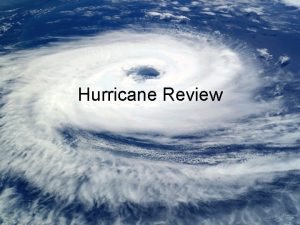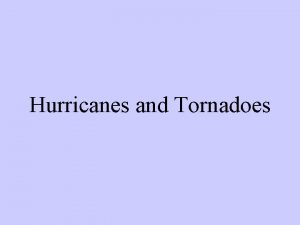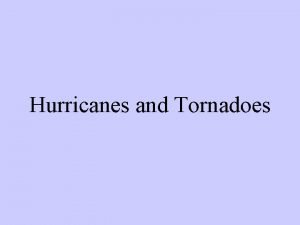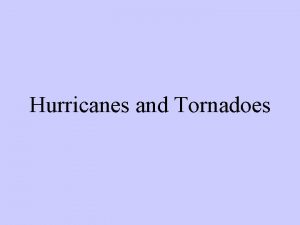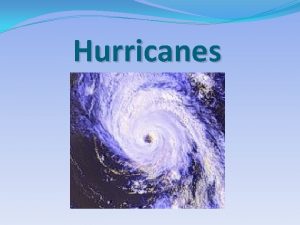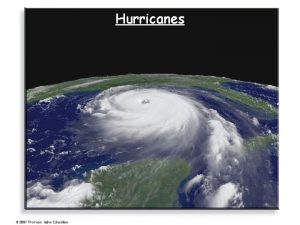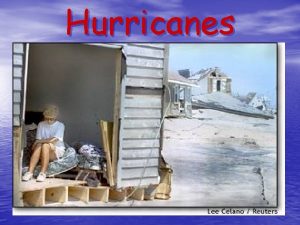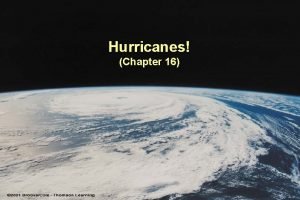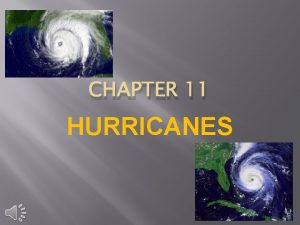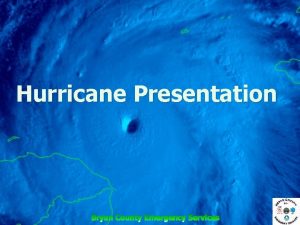Hurricanes What is a hurricane A hurricane is











- Slides: 11

Hurricanes

What is a hurricane? A hurricane is a large rotating storm with high speed winds that forms over warm waters in tropical areas. Hurricanes have sustained winds of at least 74 miles per hour and an area of low air pressure in the center called the eye.

Different Names for Hurricanes The scientific name for a hurricane is a tropical cyclone. Tropical cyclones go by different names in different places. In North America and the Caribbean they are called "hurricanes", in the Indian Ocean they are called "cyclones", and in Southeast Asia they are called "typhoons. "

How do hurricanes form? Hurricanes form over the warm ocean water of the tropics. When warm moist air over the water rises, it is replaced by cooler air. The cooler air will then warm and start to rise. This cycle causes huge storm clouds to form. These storm clouds will begin to rotate with the spin of the Earth forming an organized system. If there is enough warm water, the cycle will continue and the storm clouds and wind speeds will grow causing a hurricane to form.

Parts of a Hurricane Eye - At the center of the hurricane is the eye. The eye is an area of very low air pressure. There are generally no clouds in the eye and the wind is calm. Don't let this fool you, however, the most dangerous part of the storm is at the edge of the eye called the eye wall. • Eye wall - Around the outside of the eye is a wall made up of very heavy clouds. This is the most dangerous part of the hurricane and where the highest speed winds are. The winds at the eye wall can reach speeds of 155 miles per hour. • Rainbands - Hurricanes have large spirally bands of rain called rainbands. These bands can drop huge amounts of rainfall causing flooding when the hurricane hits land. • Diameter - Hurricanes can become huge storms. The diameter of the hurricane is measured from one side to the other. Hurricanes can span a diameter of over 600 miles. • Height - The storm clouds that power hurricanes can become very tall. A •

Where do tropical cyclones occur? Tropical cyclones occur over the ocean in areas near the equator. This is because there is plenty of warm water in these areas to allow the storms to form. There are seven major areas in the world that tend to produce tropical cyclones. See the map below.

When do hurricanes occur? Hurricanes that form in the Caribbean and the Atlantic Ocean occur between June 1 st and November 30 th each year. This is called hurricane season.

Why are hurricanes dangerous? When hurricanes strike land they can cause huge amounts of damage. Most of the damage is caused by flooding and storm surge. Storm surge is when the ocean level rises at the coastline due to the power of the storm. Hurricanes also cause damage with high speed winds that can blow down trees and damage homes. Many hurricanes can develop several small tornados as well.

How are they named? Hurricanes in the Atlantic are named based on a list of names maintained by the World Meteorological Organization. The names go in alphabetical order and the storms are named as they appear. So the first storm of the year will always have a name that starts with the letter "A. " There are six lists of names and each year a new list is used.

Categories Tropical cyclones are categorized according to the speed of sustained winds. • Tropical Depression - 38 mph or less • Tropical Storm - 39 to 73 mph Hurricane • • • Category 1 - 74 to 95 mph Category 2 - 96 to 110 mph Category 3 - 111 to 129 mph Category 4 - 130 to 156 mph Category 5 - 157 or higher mph

Interesting Facts about Hurricanes • Hurricanes rotate counterclockwise in the northern hemisphere and clockwise in the southern hemisphere. This is due to the rotation of the Earth called the Coriolis effect. • The letters Q, U, X, Y, and Z are not used for the first letter when naming hurricanes. • The names are alternated between boy and girl names. • Weather forecasters draw a cone showing where they think the hurricane is most likely to travel. • You can always find out the latest information on hurricanes at the website of the National Hurricane Center which tracks and forecasts hurricanes.
 Bill nye thunderstorms
Bill nye thunderstorms Bibliography
Bibliography Hurricane myths and legends
Hurricane myths and legends Similarities tornadoes and hurricanes
Similarities tornadoes and hurricanes Carnot cycle hurricane
Carnot cycle hurricane Compare and contrast tornadoes and hurricanes
Compare and contrast tornadoes and hurricanes Hurricanes earth's mightiest storms
Hurricanes earth's mightiest storms Hurricanes definition
Hurricanes definition Hurricanes tropical storms
Hurricanes tropical storms The global distribution of tropical storms
The global distribution of tropical storms Contrast signal words
Contrast signal words At the periphery of a hurricane, the air is ____.
At the periphery of a hurricane, the air is ____.
